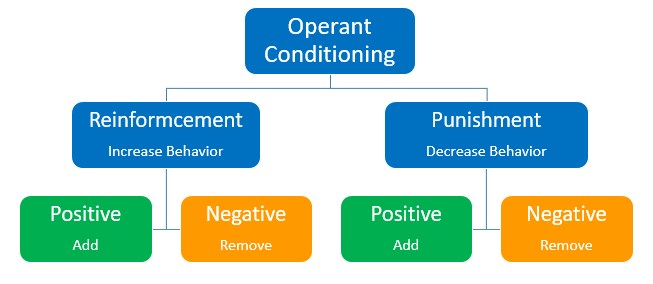Operant Conditioning
Operant conditioning is a learning process in which responses are controlled by their consequences. The likelihood of a certain response occurring is either increased or decreased due to either a reinforcement or a punishment consequence. A reinforcement helps to increase a behavior, while a punishment helps to decrease a behavior.
About Operant Conditioning
Operant conditioning involves changing voluntary behaviors. The underlying concept of this theory is that the consequences to our actions control our voluntary behavior. Therefore, if a behavior response is followed by either reinforcement or punishment, we will learn how to behave. A reinforcement following a behavior will cause the behavior to increase, while punishment following a behavior will result in decreases in the behavior. For example, if you are praised after a behavior, you will likely continue that behavior. In contrast, if you are punished after a certain behavior, you are likely to discontinue that behavior.
B.F. Skinner
The term operant conditioning was coined by a behaviorist B.F. Skinner. Skinner believed in observable and external causes of behavior instead of internal motivations and thoughts.
Skinner conducted experiments with rats using a device called the Skinner box. The box was a cage set up so the rats could automatically get a food reward if they stepped on a lever. The lever caused food to be released. From these experiments, Skinner demonstrated that behavior can be influenced by rewards or punishments. He observed how reinforcement could lead to increases in behaviors where punishment would result in decreases in behaviors.
Reinforcement
Reinforcement is a consequence that increases the likelihood a response will occur. If you are using reinforcement, you are trying to increase a behavior.
There are two types of reinforcement.
- Positive reinforcement
- Negative reinforcement
Positive means adding a stimulus, while negative means removing a stimulus. Thus, positive reinforcement is the addition of a good stimulus after a response in order to encourage the response to continue. An example of this would be giving someone praise after a desired behavior is displayed.
In contrast, negative reinforcement is the removal of an undesirable stimulus after a response so that the response will occur more often. An example of this would be fastening your seatbelt in a car so the beeping sound will stop. Since the undesirable stimulus is removed when you fasten your seatbelt, you are encourage to fasten your seatbelt.
Negative reinforcement is often confused with punishment because of its name. However, negative reinforcement involves removing a negative consequence to increase a behavior, while punishment seeks to decrease a behavior.
Punishment
Punishment is a consequence that decreases the likelihood a response will occur. If you are using punishment, you are trying to decrease a behavior.
There are two types of punishment:
- Positive punishment
- Negative punishment
Positive punishment is the addition of an undesirable stimulus after a response so that the response will occur less or stop. An example would be to give someone extra work for misbehaving.
Negative punishment is the removal of a pleasing stimulus after a response so that the response will occur less or stop. An example would be taking away television or video games from a child for misbehaving so he or she will stop misbehaving.
Links

